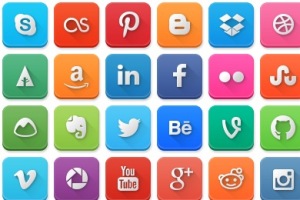
As technology changes the way we live our lives, it is also making drastic changes to the way we travel. A few years ago when I set off on my first trips as a beginner to travel without my family, the thought of taking anything other than a camera didn’t exist. To communicate with people at home I relied solely on internet cafes, postcards and an international calling card. To communicate with fellow travellers was via email, Facebook or word of mouth. Often I’d leave a note in a hostel’s guestbook in case someone I knew might be headed the same way.
The days when writer’s relied on scribbled notes in notebooks or on scrap pieces of paper collected along the way have passed. However, I do still enjoy scribbling in my travel notebook or on the edges of maps or brochures I have in my possession. These days you can make notes on a wide array of devices whether be written notes or voice recordings with many devices offering both. For example the notes for this article were made on my iPhone whilst laying in a park of Central London. I can update my blog anywhere in the world with ease. The sphere of travel journalism has changed in beat with technology with thousands of amateur travel blogs easily accessible online.
I wish I had been a traveller when the internet was scarce and communication was seemingly more meaningful, when human interaction whilst you travelled was enhanced not diminished. Think of how much more adventurous it would have been when there was no blue dot to follow or smartphone app telling you what to do and what not to do in a city.
These days the traveller is bombarded with Wi-Fi signs attempting to lure customers into their stores or cafes. Iconic sites are flooded with people looking at their smartphone either absorbed in a conversation with someone on the other side of the world or simultaneously posting a photo on Instagram, Facebook, Twitter, Tumbler then sending a cheeky Snapchat before moving on, head down, following the little blue dot, without noticing that around those little blue dots are wonders to experience. However the advances of technology and the creation of the smartphone does aid the traveller.

Getting lost
Remember when getting lost was an adventure? These days it’s almost impossible to get lost unless it is intentional. However that then begs the question whether or not you are really lost as most likely you are carrying your smartphone with you with that trusty blue dot a click away. Even without being connected to a 3G network you can step into a cafe or shop or sneakily lean against a wall outside a Starbucks or McDonald’s in the sun and connect to find out where you are. I’ve met many people who take walking tours of cities using an application such as Google’s Field Trip which takes up your location and notifications will alert you when you come across something interesting. No need to fumble with tourist maps to find your way to those iconic sites. Those trusty maps that leave out any smaller side streets that allow you to make wrong turns and get lost in the tangled web of streets in foreign cities.
Making Bookings
The booking of accommodation, transport and tours has been revolutionised and makes finding a roof to put over your head for the night a whole lot easier. Apps such as Passbook can hold all your ticket information so all you need to do at check-in is scan the barcode from your iPhone screen. You can check-in for a flight whilst stuck in traffic on the way to the airport; you can book and pay for your accommodation without having to call ahead and attempt Spanglish on the telephone to make a reservation. I now have the www.hostelworld.com app on the main screen of my iPhone along with www.orbitz.com and www.skyscanner.net applications. For those with Eurail or Interail passes for Europe this summer (www.eurail.com; www.interail.eu) you don’t even need to carry the trusty timetable around with you, as guess what? There’s a map. With Rail Mapper you type in a starting point and destination, even if it’s three countries over and five trains away. The quickest routes for the times and dates you have chosen will all be planned for you. You can even hand your smartphone with the route plan, times and dates over to station ticket staff if you are having trouble with the language barrier, making increased volume and hand gestures a thing of the past. (But where is the fun of attempting communicating where you want to go?) The application even follows the route whilst you’re in transit using each individual station scheduled times in order for it not to require internet.
Spanglish a thing of the past
The days of being completely in the lurch and not being able to find out information due to a language barrier is over. Not only are there applications for most languages that enable you to learn the basic phrases, but there is also Google Translate. On a train journey from Rome to Bari in Italy the gentleman beside me, after realising I spoke very little Italian, pulled out his iPad to establish a conversation. After an hour of typing back and forth I realised I missed the joy of attempting a conversation in another language, pulling out all the stops from my one year of studying Italian in high school. Attempting to speak the language is the only way to really learn and practise too, especially as I come from an English speaking country with no official second language. Although I enjoyed having a conversation with the gentleman on his way to visit his new born granddaughter (thank you Google Translate) I felt saddened as I could have had this conversation on an online chat room on a computer at home – this is not what I’d expect on a train through Italy.
Book or no book?
Although I am a sucker for a real book and love to turn those paper pages, lugging around a couple of novels for those long flights or boat trips can be quite a strain on your back. These days you won’t find many travellers without a device such as a kindle with a whole selection of not only novels but trusty guidebooks too. When you purchase a guidebook off the Lonely Planet website you have the option of paperback book or PDF version. This opens up extra room in your bag for more items, souvenirs or provides the option of taking a smaller bag. Since the increase in these devices though there is a noticeable reduction in book exchanges in hostels. After spending a few months travelling around Europe, I was shocked by how few books were now in the common rooms of hostels and there was a pitiful selection for anyone wanting to trade or read something new. There was one young New Zealand girl who had spent a month carrying her book around waiting for something new to trade it for after having read it twice.
Calling home
When I set out on my first taste of the world solo, Skype was all the rage. I spent many hours in internet cafes along my route on Skype to my family telling them all the adventures I had experienced. If there was no Skype facilities I would send an email or give my parents a call with my international prepaid calling card at a public telephone. Now in the addition to Smartphones, new applications such as Viber and Whatsapp are all the rage. These seem very foreign things to me and I still use trusty Skype, which has a special place in my heart as it has kept me connected to my loved ones for many years now. But I don’t need to hunt down an internet cafethat has a camera and microphone anymore as it is now downloaded onto my iPhone and I can call anytime.
As technology improves there will be new generations of travellers. I count myself as the Skype/internet café generation, before me it was the email and even earlier the letter/postcard. Today’s new generation is the social media generation with Viber, Whatsapp, Facebook, Twitter, Instagram, Snapchat and the list goes on. What’s next? Who knows? It may be a new age anti-technology hipster movement or, perhaps, teleportation.

Hey, I loved this post..yes technology has changed the way we travel (for good and for bad too)…I love getting lost and discovering things 🙂